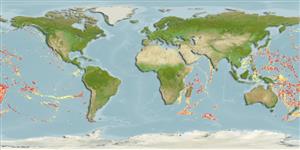Environment: milieu / climate zone / depth range / distribution range
Écologie
marin bathydémersal; profondeur 320 - 2000 m (Ref. 51655). Deep-water
Indo-West Pacific: from Tanzania, Comoros, Madagascar, to Samoa, Moluccas, Marquesas and New Guinea (Ref 9788); north to Taiwan (Ref. 129007),
Taille / Poids / Âge
Maturity: Lm ? range ? - ? cm
Max length : 13.0 cm TL mâle / non sexé; (Ref. 9788)
Description synthétique
Clés d'identification | Morphologie | Morphométrie
Épines dorsales (Total) : 6 - 9; Rayons mous dorsaux (Total) : 8 - 9; Épines anales: 3 - 6; Rayons mous anaux: 7 - 8; Vertèbres: 30 - 32.
Mesopelagic, bathy-, and benthopelagic rare species, mostly occurring over continental and island slopes. Distinctive kasidoron larval and pre-juvenile stage in epipelagic waters. Zooplankton pickers, with small crustaceans in stomachs of both pre-juveniles and adults (Ref. 9788). The largest specimen collected from Taiwan (10.3 cm SL) is a mature female with two large ovaries containing many large, loose eggs (c. 0.6-0.7 mm); while three other specimens (9.72-10.1 and 10.07 cm SL) are mature males with well-developed testis (Ref. 129007).
Life cycle and mating behavior
Maturité | Reproduction | Frai | Œufs | Fécondité | Larves
Paxton, J.R., 1999. Gibberichthyidae. Gibberfishes. p. 2203. In K.E. Carpenter and V.H. Niem (eds.) FAO species identification guide for fishery purposes. The living marine resources of the WCP. Vol. 4. Bony fishes part 2 (Mugilidae to Carangidae). FAO, Rome. (Ref. 9788)
Statut dans la liste rouge de l'IUCN (Ref. 130435: Version 2024-2)
Menace pour l'homme
Harmless
Utilisations par l'homme
Pêcheries: sans intérêt
Outils
Articles particuliers
Télécharger en XML
Sources Internet
Estimates based on models
Preferred temperature (Ref.
123201): 1.7 - 2.5, mean 2.1 °C (based on 25 cells).
Phylogenetic diversity index (Ref.
82804): PD
50 = 1.0000 [Uniqueness, from 0.5 = low to 2.0 = high].
Bayesian length-weight: a=0.01122 (0.00514 - 0.02450), b=3.04 (2.87 - 3.21), in cm total length, based on all LWR estimates for this body shape (Ref.
93245).
Niveau trophique (Ref.
69278): 3.1 ±0.30 se; based on food items.
Fishing Vulnerability (Ref.
59153): Low vulnerability (10 of 100).
